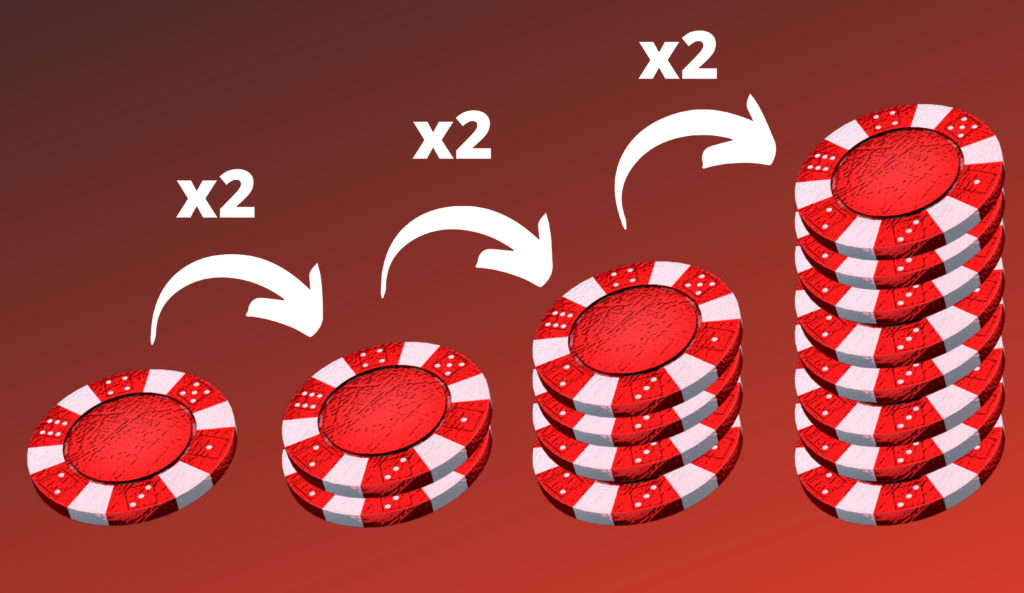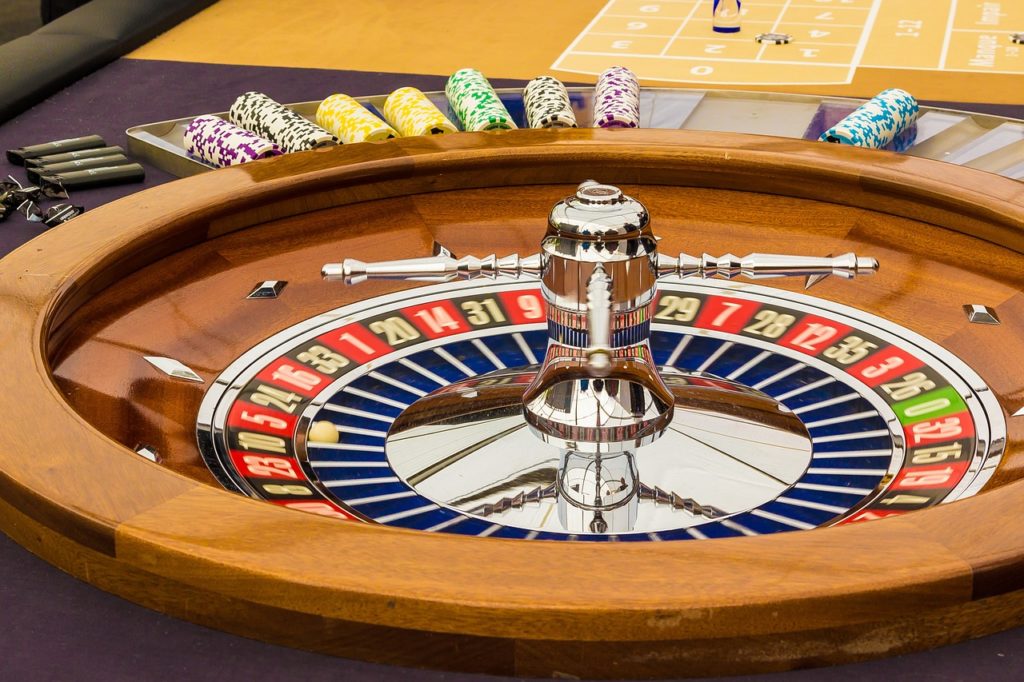Before we start explaining how the martingale strategy works, you should know that there is no betting strategy or system that can help you beat the casino. If the casinos were allowed to be easily beaten, they would’ve been long gone and not one of the most thriving industries. Betting strategies can provide you with guidelines on how to maximize profits while minimizing losses. Some strategies involve betting more when you win and others betting less when you lose.
The Martingale system is a risk-taking investment strategy. The Martingale strategy’s main principle is that you can’t lose all of the time, thus you should increase the amount you bet even when losing, in expectation of a future gain.
In the 18th century, French mathematician Paul Pierre Levy invented the Martingale system. The model was the same from the beginning, with the player raising the stakes after each defeat to ensure that the first and best win would cover the past losses. Since then, the strategy has been used in roulette and other casino games where an even-odd bet can be made. When a gambler using this system loses, they instantly increase the size of the following bet. In theory, if you double the bet every time you lose, you will eventually even out when you win. This is possible assuming you have an endless supply of money to wager or at the very least enough to get to the winning reward.
How does the Martingale Strategy work?
The Martingale strategy is one of the most well-known theories on how to invest money and create a large profit, thanks to its unique, precise, and imaginary formula. The Martingale method is based on a mathematical formula that, if the player has enough time and money, will give significant gains. People that play for a living use the Martingale formula.
In brief, the Martingale strategy doubles your wager every time you lose, increasing your odds of winning in the long run. Theoretically, you should get your original bet + profit back at some point. However, this is only in theory, and in practice, you will need an unlimited amount of money.
The Martingale system works only with even bets, meaning the bets that have a 1:1 payout. The idea behind this technique is simple: pick one of the even-odds possibilities and wager on it. If you lose a round, you double your bet and keep playing until you win a round. The first victory will make up for all of your previous losses. Furthermore, you will receive a profit equivalent to your initial wager.

Let’s have a look at a simple example to see how the strategy works. Let’s say you have a coin and want to play a game of heads or tails with a €1 beginning bet. The coin has an equal chance of landing on heads or tails, and each flip is independent. (The outcome of the previous flip has no bearing on the outcome of the subsequent flip.)
If you stick to the same call of heads or tails, given an endless amount of money, you’ll ultimately see the coin land on heads (or tails, if that’s your call) and recoup all of your losses, plus €1.
So, assuming your initial wager was €1, the progression will be as follows:
1 – 2 – 4 – 8 – 16 – 32 – 64 – 128 – 256 – 512 – 1024 – 2048 – 4096 – 8192…
However, this only works in theory because there are numerous other elements that might influence the outcome of the game and prevent you from winning more.
Martingale Strategy in Roulette
The Martingale system was first used in roulette and it works only for even odds bets, as we previously mentioned. So, in roulette, you can use it to wager on colour (red/black), even/odd, or high/low. These bets have the lowest payoff, which is 1:1, but the best odds of winning, which are 48.60% (European Roulette). You don’t have to bet on just one of these wagers during the game any longer. You might begin by betting on colour, then move on to high/low. It doesn’t matter as long as the odds are in your favour.
It’s advisable to start with the smallest amount possible when applying the Martingale system in roulette. All the online casinos in Kenya have roulette games in their portfolio, so you can register and start using this system. But, if you want to use the Martingale approach, we recommend avoiding tables with high minimums.
Assume you start with a €1 stake on black. You lose your €1 if the ball lands on a red. Your next bet is €2 on black, which you lose again. You’ve already lost €3 at this point. The third stake is double the second bet, which is €4, and you bet on black once more. You win €4 if the ball lands on black. With this win, you were able to cover your losses of €3 and make a profit of €1 on your original bet. After the win, you return to your original wager and begin the sequence all over again.
In theory, the concept is logical, even if the chances are constantly stacked against the player in the long run. This is because of the green Zero, which represents the house advantage.

Disadvantages of the Martingale Strategy
The Martingale strategy is ideal in theory, as we’ve stated numerous times. However, we also emphasized that there is a slew of other elements that play a role in the game’s outcome.
First and foremost, there is the house advantage or house edge. Whatever you do, the house will always come out on top. The green zero is the major opponent in roulette, representing the house edge and changing the odds against you.
Another possibility is that you will surpass the table’s maximum bet limit. If you’ve lost too many rounds in a row, you’ll be required to duplicate your bets over and over again until you reach the table’s maximum wager limit. Once you’ve reached the maximum limit, you won’t be able to double again, and you’ll be unable to pay your losses.
One of the disadvantages of the Martingale system is that it might quickly run out of money. If you have a string of losing rounds, doubling up every time you lose can quickly deplete your bankroll, forcing you to give up before you have a chance to recoup your losses.
Martingale Strategy Variations
Grand Martingale System
The Grand Martingale Strategy is a famous variant of the Martingale system. This is a boosted version of the original because, in addition to doubling the bet after each loss, you must also add one more unit. If you lose a €1 bet, for example, the next wager you should make is €3 total if you are utilizing the Grand Martingale Strategy.
With the Grand Martingale system the progression will be as follows:
1 – 3 – 7 – 15 – 31 – 63 – 127 – 255 – 511…
All of the disadvantages of the Martingale strategy apply to this variation as well. But this time it’s a little different. Especially when it comes to reaching the bet limit. Because you wager plus 1 every time you use the Grand Martingale approach, you will reach the maximum considerably faster, and the window of chance to win and recover prior losses will be shorter. Furthermore, you may run out of money more quickly.
So, while this variation is unquestionably riskier when you do win, you win more than when applying the Martingale strategy.
Triple Martingale System
This is the riskiest of all the variations, so we don’t recommend it unless you’re confident in your ability to take a big risk and lose a lot of money. Instead of doubling your stake after each loss, you triple your bet in this variation, as the name implies. So, if you wager €1 and lose, you’ll have to bet €3 the next time. Your bet goes up to €9 after another loss. If you’re having bad luck and have 6 lost rounds, you’ve already lost €243 using the Triple Martingale strategy.
If chance isn’t on your side, you risk surpassing the table limit rapidly or losing all of your money in a few rounds if you use the Triple Martingale strategy.
Reverse Martingale Strategy
The Reverse Martingale strategy is the opposite of the Martingale system. If you use this system, every time you win, you double your bet and start again if you lose. Since the losses are limited, the strategy is less dangerous. When you begin a progression, you are only risking the initial stake. When you double your stake after winning a round, you are actually using the profits from the previous round.
You can use a number of different approaches. Limiting your progression to three wins and then restarting is the safest option. You won’t win a lot, but you’ll have a better chance of leaving the game with a profit. On the other hand, you can go all-in and keep doubling your money after every win until you hit the table limit. This strategy is riskier and less likely to succeed, but the rewards are unquestionably greater.
Is Martingale Strategy good?
Despite the constraints listed above, the Martingale may and should be used. As long as you know what you’re getting out of the system, that is. The Martingale is ideal for players who are ready to risk losing a significant amount of money on occasion in exchange for repeated small winnings. If you apply the Martingale in a casino, you’ll probably end up with small wins most of the time, something that many gamblers will appreciate.
